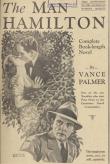AustLit
The material on this page is available to AustLit subscribers. If you are a subscriber or are from a subscribing organisation, please log in to gain full access. To explore options for subscribing to this unique teaching, research, and publishing resource for Australian culture and storytelling, please contact us or find out more.
Latest Issues
Publication Details of Only Known VersionEarliest 2 Known Versions of
Works about this Work
-
Finding a Spiritual Home in the Australian Environment : Katharine Susannah Prichard and Vance Palmer in the 1920s
2013
single work
criticism
— Appears in: Australasian Journal of Ecocriticism and Cultural Ecology , no. 3 2013; 'Eco-centric ideologies recognise humans as an interdependent part of a larger biotic community and the biophysical systems that support them. Constructions and narratives of one’s ‘spiritual home’ in the environment by authors and critics can challenge colonial and postcolonial understandings, of — in this instance — Australia. Vance Palmer, Australia’s leading man of letters of the inter-war period, claimed his was a generation seeking to find ‘harmony’ with the environment; Nettie Palmer believed that writers’ powers depended on their capacity to find a spiritual home in place. Without the literary imagination, people and places appear ‘uncanny and ghostlike’, and Nettie evolved a schema in and through language to help others learn how to dwell in the land. In a time of rapid environmental change, this essay re-visits these writers, that is, Vance and Nettie Palmer, Katharine Susannah Prichard and others of their generation, and it investigates their important initiatives in challenging dominant and habitual ways of understanding and seeing the natural environment. Often as a result of their beliefs they sought out remote country locations and ‘wilderness areas’ in which to live and write about. Two key texts, Working Bullocks (1926) by Prichard and The Man Hamilton (1928) by Palmer, can be explored in context of recent discourses on ecological sensibilities, identities of place and transnational cosmopolitanism, home and homecoming in the literary imagination, and rapid change through climate change. Building on earlier literary critiques and gender analysis, very different readings of the environmental imagination at play in these texts are possible.' (Publication abstract) -
Untitled
1961
single work
review
— Appears in: Meanjin Quarterly , September vol. 20 no. 3 1961; (p. 346) Hemisphere , November/December vol. 26 no. 3 1981; (p. 162-163)
— Review of The Man Hamilton 1928 single work novel -
Untitled
1960
single work
column
— Appears in: The Bulletin , 3 August vol. 81 no. 4199 1960; (p. 66)
— Review of The Man Hamilton 1928 single work novel -
The Novels
1959
single work
criticism
— Appears in: Meanjin , July vol. 18 no. 2 1959; (p. 146-172) -
Vance Palmer
1938
single work
criticism
— Appears in: Essays in Australian Fiction 1938; (p. 81-120)
-
Untitled
1928
single work
review
— Appears in: The Times Literary Supplement , 19 July 1928; (p. 537)
— Review of The Man Hamilton 1928 single work novel -
Vance Palmer
1928
single work
review
— Appears in: The Brisbane Courier , 1 September no. 22028 1928; (p. 22)
— Review of The Man Hamilton 1928 single work novel -
Untitled
1928
single work
review
— Appears in: The Australasian , 8 December vol. 125 no. 4170 1928; (p. 8)
— Review of The Man Hamilton 1928 single work novel -
Untitled
1928
single work
review
— Appears in: The Daily Mail , 15 December 1928; (p. 18)
— Review of The Man Hamilton 1928 single work novel -
Vance Palmer
1928
single work
review
— Appears in: The Brisbane Courier , 22 December 1928; (p. 20)
— Review of The Man Hamilton 1928 single work novel -
The Novels
1959
single work
criticism
— Appears in: Meanjin , July vol. 18 no. 2 1959; (p. 146-172) -
Vance Palmer
1938
single work
criticism
— Appears in: Essays in Australian Fiction 1938; (p. 81-120) -
Finding a Spiritual Home in the Australian Environment : Katharine Susannah Prichard and Vance Palmer in the 1920s
2013
single work
criticism
— Appears in: Australasian Journal of Ecocriticism and Cultural Ecology , no. 3 2013; 'Eco-centric ideologies recognise humans as an interdependent part of a larger biotic community and the biophysical systems that support them. Constructions and narratives of one’s ‘spiritual home’ in the environment by authors and critics can challenge colonial and postcolonial understandings, of — in this instance — Australia. Vance Palmer, Australia’s leading man of letters of the inter-war period, claimed his was a generation seeking to find ‘harmony’ with the environment; Nettie Palmer believed that writers’ powers depended on their capacity to find a spiritual home in place. Without the literary imagination, people and places appear ‘uncanny and ghostlike’, and Nettie evolved a schema in and through language to help others learn how to dwell in the land. In a time of rapid environmental change, this essay re-visits these writers, that is, Vance and Nettie Palmer, Katharine Susannah Prichard and others of their generation, and it investigates their important initiatives in challenging dominant and habitual ways of understanding and seeing the natural environment. Often as a result of their beliefs they sought out remote country locations and ‘wilderness areas’ in which to live and write about. Two key texts, Working Bullocks (1926) by Prichard and The Man Hamilton (1928) by Palmer, can be explored in context of recent discourses on ecological sensibilities, identities of place and transnational cosmopolitanism, home and homecoming in the literary imagination, and rapid change through climate change. Building on earlier literary critiques and gender analysis, very different readings of the environmental imagination at play in these texts are possible.' (Publication abstract)
Last amended 10 Dec 2015 10:54:30
Subjects:
- Bush,
- Queensland,
Export this record




